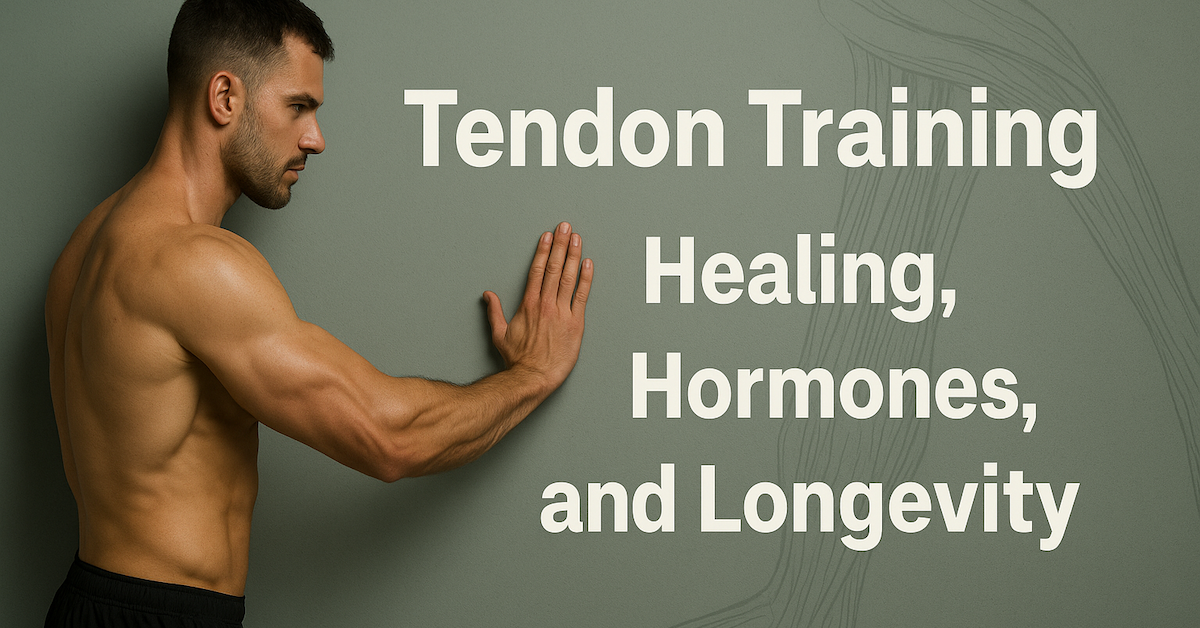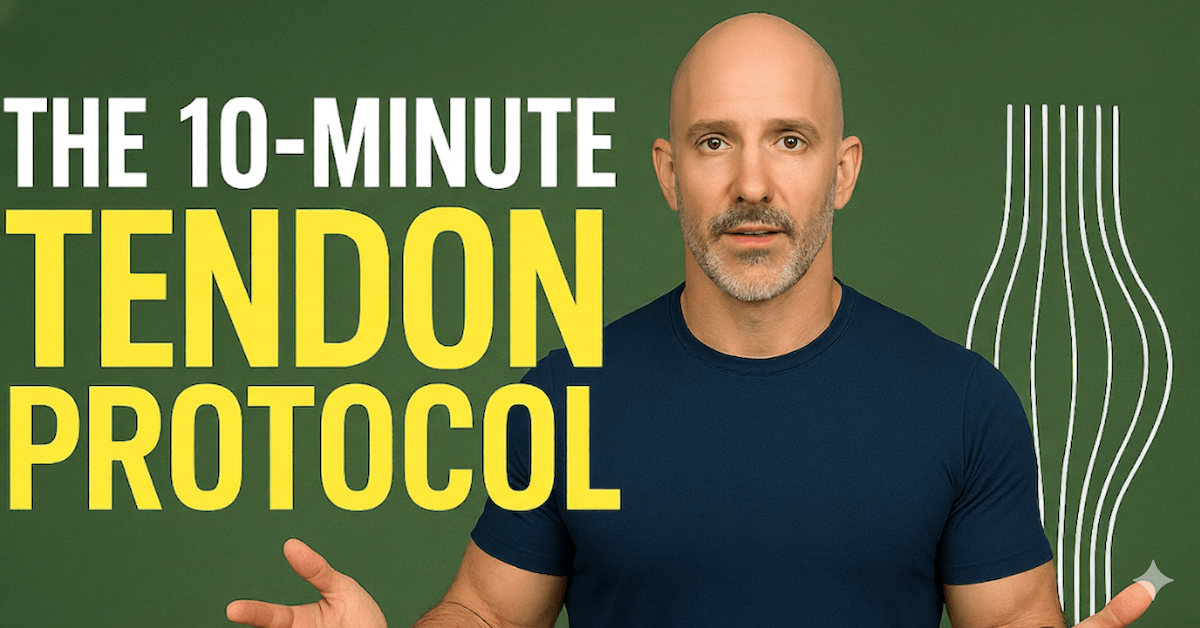If you’ve followed our tendon training series so far, you know that Dr. Keith Baar’s research has reshaped how we think about connective tissue health. In Part 1, we introduced the 10-minute tendon protocol. In Part 2, we explored advanced insights on healing, hormones, and longevity. Now, in Part 3, we dive deeper into the science of load, recovery, and practical application — including a video demonstration to help you implement these strategies today.
Load Is Life: Why Tendons Need Stress to Survive
Tendons don’t just respond to load — they depend on it. Without mechanical stress, they begin to degrade rapidly. In fact, just three days of unloading can lead to a 20% loss in collagen, with levels plateauing at this reduced state within two weeks.
The key to healing isn’t movement — it’s targeted isometric loading. Light dynamic rehab (like resistance bands) often fails because it stress-shields the injured area, allowing healthy tissue to take the load while the damaged section remains untouched. Isometric holds (30 seconds × 4 reps at ~40–50% effort) direct force through the injury, stimulating collagen synthesis and fiber alignment.
The 10-Minute Rule: Timing Is Everything
Unlike muscle or cardiovascular tissue, tendons become refractory to loading signals after about 10 minutes. That means longer sessions don’t lead to more adaptation — just more wear and tear.
Dr. Baar recommends two short sessions per day, spaced 6–8 hours apart. This structure doubles the collagen synthesis response compared to a single longer session. It’s a simple but powerful shift in training strategy.
Isometrics vs. Dynamics: Gene Activation Matters
Here’s a surprising insight:
- 4 × 30-second isometric holds activate tendon-specific genes.
- 300+ dynamic reps with the same time-under-tension activate cartilage genes instead.
It’s not the movement that matters — it’s the duration of load. This distinction is critical for rehab and performance.
Aging, Elasticity & Cross-Linking
As we age, tendons become stiffer due to increased collagen cross-linking. But stiffness isn’t the goal — elasticity is. Healthy tendons strike a balance: stiff enough to transmit force, elastic enough to glide and recoil efficiently.
Adhesions between tissue layers reduce elasticity, limiting movement quality. Regular loading and movement — especially in lengthened positions — help prevent these adhesions and maintain tendon health.
Hormones and Gender Differences
Hormonal fluctuations play a major role in tendon injury risk:
- Estrogen suppresses lysyl oxidase, the enzyme responsible for collagen cross-linking. This reduces tendon stiffness and increases ACL rupture risk — especially around ovulation.
- Testosterone increases cross-linking, resulting in stiffer but more brittle tendons. This may explain why men experience more muscle tears.
Understanding these differences can inform training and rehab strategies for both men and women.
Rehab Principles: Precision Over Intensity
Effective tendon rehab follows a clear protocol:
- Hold isometrics in a pain-free range: 30 seconds × 4 reps, ~2 minutes rest.
- Perform twice daily (morning and evening) for 8 weeks to regenerate tissue.
- Maintain with weekly sessions to prevent relapse.
- Progress by increasing hold duration and control, not load.
- Use isometrics after sport to re-load fatigued tissues and reduce reinjury risk.
Nutrition & Recovery: Feed the Fibers
To maximize collagen synthesis:
- Take collagen + vitamin C 30–60 minutes before loading.
- Avoid NSAIDs, antioxidants, and ice baths immediately after tendon work — they blunt the inflammatory response needed for remodeling.
- Moderate inflammation is essential for healing.
Practical Applications: Movement as Medicine
Mobility work like yoga or Tai Chi — which uses isometric holds in lengthened positions — can maintain tendon health for life. Just 10 minutes for upper body + 10 minutes for lower body daily is enough.
Consistency beats intensity. Daily short exposures outperform infrequent hard sessions.
Watch the Demonstration
Here’s a practical breakdown of the isometric exercises Dr. Baar recommends:
Conclusion
This article builds on the foundation laid in our previous posts. If you haven’t read them yet, start here:
Let’s keep raising the standard of fitness education — one tendon at a time.

Injury Prevention Strategies for Aging Athletes
As athletes age, the risk of injury grows—and recovery takes longer. Injury Prevention Strategies for Aging Athletes reveals proven methods to help you stay strong, resilient, and active for years to come. In this 60-minute webinar, John Paul Catanzaro shares practical tips you can use immediately to reduce injury risk both on the field and in the gym.
- aging, athletic performance, collagen, collagen supplementation, connective tissue, Dr. Keith Baar, hormones, injury prevention, isometric exercises, isometrics, Keith Baar, ligament strength, nutrition for tendons, polyphenol benefits, rehabilitation, Sinewus, strength training, tendon health, tendon rehabilitation

Tendon Training 2.0: Advanced Insights on Healing, Hormones, and Longevity
If you haven’t read Part 1 — The 10-Minute Tendon Protocol: How to Build Stronger, Injury-Proof Tissue — start there

The 10-Minute Tendon Protocol: How to Build Stronger, Injury-Proof Tissue
Most athletes train muscles. The smart ones train tendons. The problem? Tendons don’t give you warning signs. There’s no such

Why METH Beats RICE for Injury Recovery: Science Finally Catches Up
Back in 2012, I introduced a controversial—but far more effective—approach to treating soft-tissue injuries. The acronym? METH, which stands for:
follow
Error: No feed with the ID 2 found.
Please go to the Instagram Feed settings page to create a feed.
